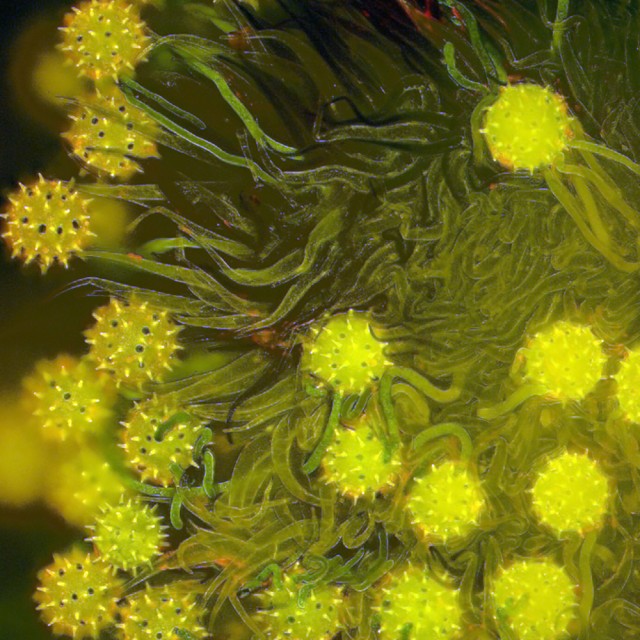Small But Not Forgotten

Pollen grains may be small but they have a big job. Delivering a sperm to an egg is a little more complicated when the parents don’t move around.
For plants, pollen success means reaching a receptive stigma, germinating and growing a pollen tube into the ovary, locating an ovule and only then entering and delivering a sperm to a receptive egg. Despite the importance of these events to plant reproduction, pollen performance is relatively understudied.
To address that gap, UC Santa Barbara botanist Susan Mazer and her colleague Joe Williams of the University of Tennessee organized a symposium at Botany 2014 that has now culminated in a special issue of the American Journal of Botany titled “The Ecology and Evolution of Pollen Performance.”
“We soon found a surprising number of labs around the world interested in pollen evolution from a functional standpoint,” said Mazer, a professor in UCSB’s Department of Ecology, Evolution, and Marine Biology.
“For my part, in trying to understand the early evolution of male gametophyte performance traits in flowering plants, I found it frustrating that so much of the research was focused on consequences for sporophyte fitness alone,” said Williams. “Where were the papers on gametophyte fitness traits?”
Although many turn their attention to pollen only as it relates to allergy season, scientists have undertaken a wide variety of research on pollen performance, as demonstrated by the articles in the special issue. Some findings, for example, focus on the interactions between pollen grains and how competition — similar to that among animal sperm — can drive fitness outcomes. Other investigations have shown that success is not entirely a function of the male traits, since the interactions between pollen and female tissues can also explain some of the variability in pollen performance.
Pollen structure has long been used to classify plants, but these traits can also have function, and a number of the papers explore these characteristics in detail. Upon landing on a stigma, pollen needs to transition from a desiccated dominant state to a hydrated germinating grain, and this can be governed by the number of apertures and the hydrogel properties. Pollen size can also be important for fitness, but so is pollen tube growth rate. “These examples suggest there is knowledge to be gained by zooming in on these tiny gametophytes,” Mazer said.
By focusing on the microscopic traits of individual grains, articles in the special issue also seek to understand the effects of other processes such as inbreeding and disease on pollen performance. A broader look shows that interactions with pollinators can affect pollen performance, and comparisons of pollen performance between core populations and range limits can provide further insights.
This collection of papers gathers diverse perspectives on pollen performance and lays out clear examples of how to test these ideas. Because this special issue represents a broad range of taxa and approaches to studying pollen performance, Mazer noted that it is likely to ignite renewed interest in pollen performance, particularly among young researchers. “Surely the time is ripe for evolutionary biologists to refine their ideas based on our deeper understanding of the traits that determine gametophyte fitness,” Williams said.